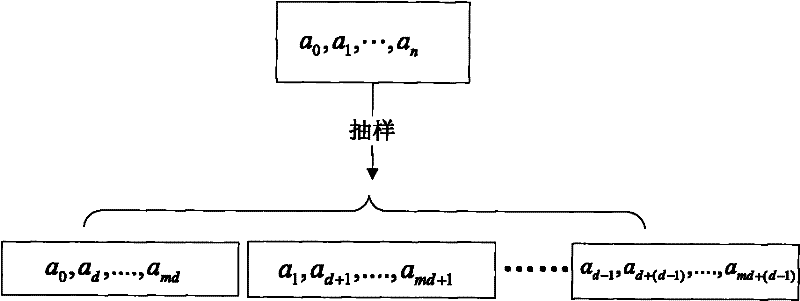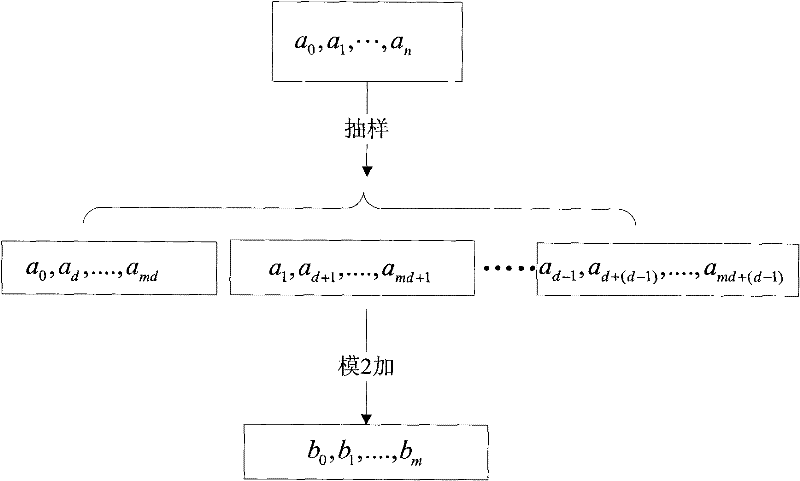Randomness detecting method based on pseudo-random sequence of sample
A technology of randomness detection and pseudo-random sequence, which is applied in the field of randomness detection of pseudo-random sequence, which can solve problems such as limitations and one-sidedness, affecting detection accuracy, etc., to improve accuracy, solve limitations and one-sidedness, and avoid misjudgment Effect
- Summary
- Abstract
- Description
- Claims
- Application Information
AI Technical Summary
Problems solved by technology
Method used
Image
Examples
Embodiment 1
[0032] Embodiment 1, by sampling the sequence to be tested, the randomness detection of the pseudo-random sequence is realized,
[0033] refer to figure 1 and figure 2 , the specific implementation steps of this example are as follows:
[0034] Step 1, input the sequence to be tested a 0 , a 1 ,...,a n , n=10 6 .
[0035] Step 2: Sampling the sequence to be tested, set the sampling interval as a positive integer d, and obtain the sampling sequence as a 0 ,...,a md , a 1 ,...,a md+1 ,...,a d-1 ,...,a md+(d-1) , m=(n+1) / (d-1).
[0036] Step 3, for the sampling sequence a 0 ,...,a md , a 1 ,...,a md+1 ,...,a d-1 ,...,a md+(d-1) Use the transformed point test method for statistics:
[0037] (3a) Take a sequence s that has been proven to be pseudo-random 0 ,s 1 ,...,s l(l=10 6 ) as a standard sequence, placed in a 0 ,...,a md , a 1 ,...,a md+1 ,...,a d-1 ,...,a md+(d-1) Before, form a new sequence s 0 ,s 1 ,...,s l , a 0 ,...,a md , a 1 ,...,a m...
Embodiment 2
[0046] Embodiment two, realize the randomness detection of the pseudo-random sequence by adding the sampling modulo 2 of the sequence to be tested,
[0047] refer to figure 1 and image 3 , the specific implementation steps of this example are as follows:
[0048] Step 1, input the sequence to be tested a 0 , a 1 ,...,a n , n=10 6 .
[0049] Step 2: Sampling the sequence to be tested, setting the sampling interval as a positive integer d, and obtaining the sampling sequence as a 0 ,...,a md , a 1 ,...,a md+1 ,...,a d-1 ,...,a md+(d-1) , m=(n+1) / (d-1).
[0050] Step 3, for the above sampling sequence a 0 ,...,a md , a 1 ,...,a md+1 ,...,a d-1 ,...,a md+(d-1) Modulo 2 addition bit by bit: b i = a id ⊕ a id + 1 · · · ⊕ a ...
PUM
 Login to View More
Login to View More Abstract
Description
Claims
Application Information
 Login to View More
Login to View More - R&D
- Intellectual Property
- Life Sciences
- Materials
- Tech Scout
- Unparalleled Data Quality
- Higher Quality Content
- 60% Fewer Hallucinations
Browse by: Latest US Patents, China's latest patents, Technical Efficacy Thesaurus, Application Domain, Technology Topic, Popular Technical Reports.
© 2025 PatSnap. All rights reserved.Legal|Privacy policy|Modern Slavery Act Transparency Statement|Sitemap|About US| Contact US: help@patsnap.com



